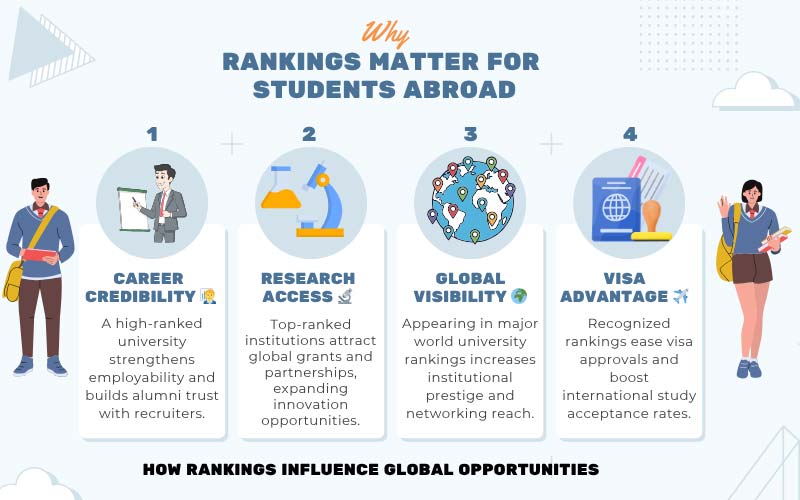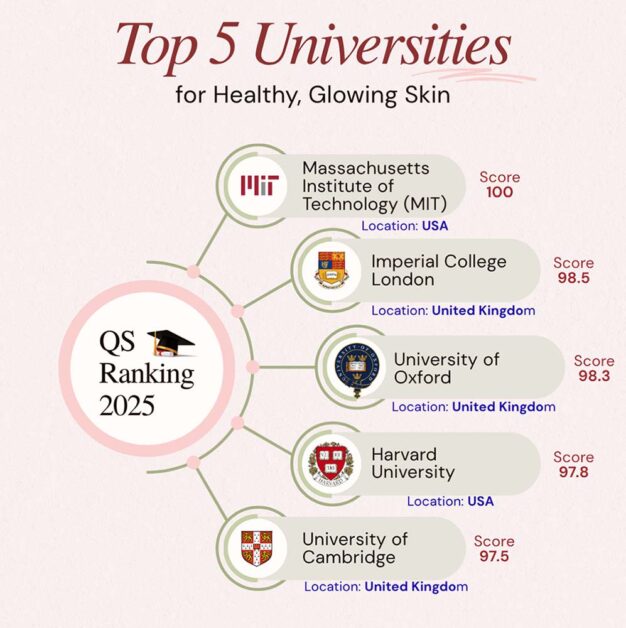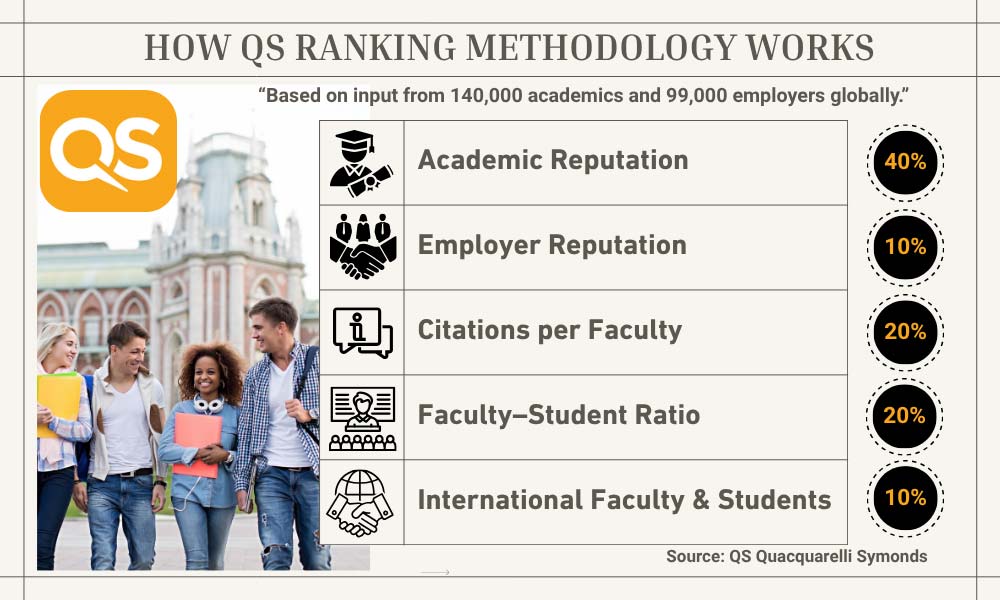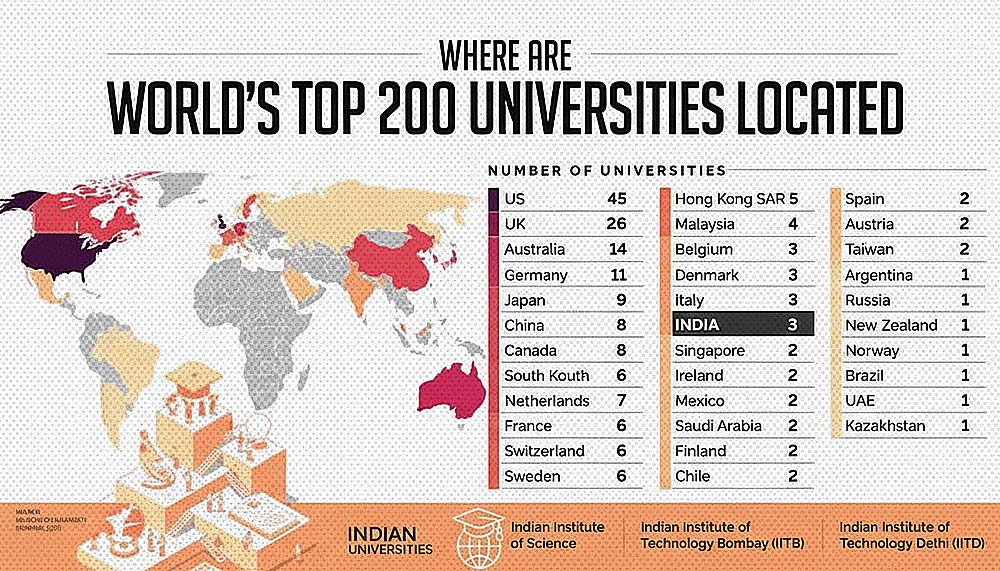“Which university should my child apply to — QS ranked or Times Higher Education ranked?” It’s a common question we hear from anxious parents and ambitious students scrolling through global university rankings before making their study abroad choice. The QS Ranking often feels like the gold standard . A quick way to identify top universities in the world and compare study abroad universities across continents.

Having worked in the mass communication industry for over 32 years, and as a certified business coach. I have seen how perception often overshadows purpose in these decisions. Are higher numbers always better? Understanding the QS Ranking is about more than prestige. It reflects how reputation, research, and international outlook create real opportunities.
In this article, we will explore how universities are ranked worldwide and how understanding the system helps you choose wisely, not just widely.
Also Read:
- Global Education Trends: Student Immersion Programs
- Study Abroad Trends 2025: Indian Students Shaping Global Careers
- Bagram Air Base & India’s New Afghanistan Strategy
Why University Rankings Matter for Study Abroad Students
Rankings influence global recognition, scholarship opportunities, and job prospects. For international students, they often become the first filter when shortlisting top universities in the world. They simplify complex choices and signal the credibility of study abroad universities worldwide.

What Is the QS Ranking?
The QS Ranking, created by Quacquarelli Symonds (QS), is a global university assessment system. It evaluates institutions using factors like academic reputation, employer feedback, research impact, teaching quality, and international diversity to identify the world’s leading universities each year.

Here is why university rankings hold importance:
- Reputation for employers and alumni credibility. A higher-ranked university enhances employability. Recruiters often associate strong rankings with quality education, influential alumni, and better career readiness.
- Access to global research opportunities and funding. Top-ranked universities attract larger research grants and global collaborations, offering students exposure to cutting-edge projects.
- Visibility in best global universities lists. Appearing in global university rankings boosts institutional visibility, helping students access better networks and partnerships.
- Prestige in visa and immigration approvals. High-ranked universities often enjoy smoother visa processes and government recognition, easing international admissions.
Key Insight: University rankings open doors to scholarships, global networks, and research opportunities. For students, they serve as both a guidepost and a mark of credibility in a highly competitive education market.\
QS Ranking Stats
The QS World University Rankings 2025 is for world’s leading institutions. It demonstrates exceptional performance in research, teaching, and global outlook. Thus reinforcing the dominance of top universities in the world across international higher education benchmarks.
- Massachusetts Institute of Technology (MIT)
- Imperial College London
- University of Oxford
- Harvard University
- University of Cambridge

MIT again secured first place, maintaining a perfect score in several metrics. These rankings reflect how QS balances reputation, research, teaching, and international outlook to distinguish top universities in the world.
How QS Ranking Methodology Works
The QS World University Rankings 1remains the most popular and widely trusted source for comparing universities worldwide. It evaluates institutions through six key indicators that blend academic reputation, employer opinion, research excellence, teaching quality, and international outlook — forming a balanced global university assessment.
1️⃣ Academic and Employer Reputation
Academic reputation holds the highest weight in the QS Ranking, contributing 40 percent of the total score. This measure is based on global surveys from educators and researchers who rate institutions for academic excellence, publications, and influence.
Employer reputation contributes another 10 percent. Thousands of employers across industries assess which universities produce graduates who perform well in the workforce. This makes QS Rankings especially valuable for students choosing study abroad universities that align with career goals.
Together, these indicators reflect both intellectual credibility and job market readiness. Each year, QS gathers input from over 140,000 academics and 99,000 employers worldwide. These large-scale surveys make the QS Ranking one of the most representative global university ranking systems.

2️⃣ Research Output and Citations
Research2 plays a decisive role in the QS Ranking system. Citations per faculty measure the influence and quality of academic work produced by universities. A higher citation count signals stronger research impact and contribution to global knowledge.
The volume and quality of publications reflect institutional strength in research disciplines. For example, STEM-focused universities the Indian Institutes of Technology, University of Oxford, Indian Institute of Science, MIT, Stanford, and Caltech in the USA, University of Cambridge UK often rank higher because their studies generate more citations in global databases like Scopus.
This metric ensures that universities are evaluated not just for teaching but also for how they advance science, innovation, and academic collaboration.
3️⃣ Teaching Quality and International Outlook
A low faculty-to-student ratio reflects greater teaching attention and mentorship quality. It shows how effectively universities invest in personalized learning and academic support.
International outlook measures the diversity of students and faculty on campus. Institutions that welcome global participation score higher, offering study abroad students an inclusive and multicultural experience. For a detailed breakdown of each indicator, visit the QS World Rankings methodology.
Regional Trends in Global University Rankings
In recent years, Asian universities have steadily increased their share in the QS World University Rankings. The 2025 data shows a record number of institutions from China, Singapore, and South Korea in the global top 100, reflecting rapid growth in research and innovation. For detailed subject-wise performance, explore the QS regional and subject rankings

Delhi University’s steady climb in the QS World Rankings 2025 marks a proud moment for Indian higher education. Though no Indian institution reached the top 200 this year. DU’s 220th position highlights the nation’s growing focus on sustainability, academic quality, and global relevance.
Lesson: The QS Ranking explained simply — academic reputation and employability together make up nearly half of the score, making these rankings a powerful guide for students selecting universities abroad.
Comparing QS with Times Higher Education and U.S. News
While the QS Ranking dominates in visibility and recognition, other frameworks like Times Higher Education (THE) and U.S. News & World Report use distinct evaluation criteria3. Together, they create variation in how the best global universities appear across world university rankings.
Here’s how these systems differ:
| Ranking System | Primary Focus Areas | Best For |
| QS Ranking | Academic reputation (40%), employer reputation (10%), faculty-student ratio, research citations, international students, and faculty | Students seeking career-focused, globally recognized universities |
| Times Higher Education (THE) | Teaching environment, research volume, industry income, international outlook | Students valuing academic experience and research-driven learning |
| U.S. News & World Report | Research reputation, publications, international collaboration, regional research influence | Students aiming for research-oriented or regionally strong institutions |
Each ranking system serves a unique purpose. Some highlight academic rigor, while others reward employability or innovation. Students who understand these differences can interpret ranking variations with greater clarity.
Looking Ahead: Each framework highlights different strengths. Students should explore multiple rankings to identify institutions that excel in teaching, research, or employability — depending on their individual priorities and study abroad goals.
Should Rankings Define Study Abroad Universities?
Rankings are helpful, but according to insights from global scholarship database, they cannot define the entire study abroad journey. Students must look beyond numbers and balance global university rankings with practical aspects like academic fit, lifestyle, and long-term career goals before finalizing their study abroad universities.

Here’s what truly matters when choosing a university:
- Course and curriculum relevance for career goals. Select programs that align with your desired profession, not just the ranking position.
- Teaching quality and learning environment. Smaller class sizes, research access, and faculty mentoring often impact success more than rankings.
- Cost of living, tuition, and scholarships. Financial feasibility determines how well you can focus on your studies and personal growth.
- Work visa options and post-study opportunities. Choose destinations that offer strong job markets and post-graduation pathways.
- Campus culture and student lifestyle. A welcoming, inclusive environment enhances emotional well-being and cross-cultural learning.
More than 60% of international scholarship programs reference global university rankings, including the QS Ranking, when determining eligibility. Several prestigious programs, such as the Lund University Global Scholarship, offer merit-based tuition waivers and often consider ranking credibility during selection. While not every scheme specifies ranking cutoffs, many government and institutional scholarships still use world university rankings as filters for shortlisting applicants. Recent analyses suggest that 50–70% of international merit scholarships rely on ranking status as part of their eligibility criteria.

Practical Note:. While global university rankings are useful for shortlisting institutions, factors like personal fit, affordability, and employability should guide your final decision. The QS Ranking is a starting point, not the destination. Smart choices combine ambition with practicality.
Also Read:
- Global Education Trends: Student Immersion Programs
- Export-Ready Insulation Materials: India’s Global OEM Advantage
FAQ: QS Ranking
How are top universities in the world ranked?
Universities are ranked through reputation surveys, research citations, teaching quality, international diversity, and alumni outcomes. These indicators together measure academic strength, employability, and global impact in world university rankings.
Which is better, QS or Times Higher Education?
QS focuses on academic and employer reputation, while Times Higher Education values teaching and research environment. Both are globally respected, but QS is often preferred by students seeking career-focused, internationally recognized study abroad universities.
Do rankings affect scholarships for study abroad?
Yes. Many scholarship providers and government programs use global university rankings, especially the QS Ranking, to assess eligibility, institutional credibility, and academic excellence when awarding financial aid to international students.
What is the weighting of indicators in the QS Ranking?
The QS Ranking uses six indicators: Academic Reputation (40%), Employer Reputation (10%), Citations per Faculty (20%), Faculty-Student Ratio (20%), and International Student and Faculty Ratios (10%) to evaluate university performance globally.
Conclusion
The QS Ranking continues to be one of the most trusted tools for comparing universities worldwide. It offers valuable insight into reputation, research, and employability, helping students identify top study abroad universities. However, rankings alone cannot define the best fit.
Personal goals, academic interests, financial planning, and cultural adaptability are equally important when choosing where to study. Global university rankings act as a guide, not a guarantee.
At TrendVisionz, we help students look beyond numbers to discover opportunities that match their potential. Explore deeper with our insights on admissions, scholarships, and career planning to make informed, confident study abroad decisions.
Additional Resources:
- QS Quacquarelli Symonds. (2025). QS World University Rankings 2025: Methodology and results. Retrieved on 7th Oct, 2025 ↩︎
- Frontiers in Education (2025). Unpacking the metrics: A critical analysis of the 2025 QS World University Rankings. Retrieved from Frontiers in Education Journal ↩︎
- U.S. News & World Report. (2024). How U.S. News calculated the Best Global Universities rankings. Retrieved from U.S. News Methodology ↩︎
Stay Connected with Me:
Anuj Mahajan is a Mass Communication Specialist, ICF-ACC Certified Coach, Corporate Trainer, Motivational Speaker, NLP Life Coach, Filmmaker, and Author. With 30+ years in media, marketing, and leadership coaching, he unites storytelling, mindfulness, and digital transformation.
- Explore my work: Nuteq Entertainment | TrendVisionz | Author Profile
- Read our newsletters: Transforming Lives | BizTech Chronicle | Nuteq Newsline
- Guest writer: BizCatalyst360 | Praja Today
- Books: Go Mindfulness: Practices for Professionals Coached
- Join the community: LinkedIn Group – Digital Marketing & Content Creation World
- Connect with me: LinkedIn | Twitter | #StoryforBusiness
- Share your review: Leave your review on Google — your feedback helps us grow.
- Listen on Spotify: Leadership Podcast | Guided NLP (7 Episodes) | Daily Motivation – 21 Episodes
Believe. Practice. Perform. Let’s create impact together.
✍️ A Note from the Editor
Independent storytelling thrives with you. Contribute $15/month via PayPal or email us at anujmahajan@trendvisionz.com. [Guest write for us — Free or Paid.]



8 comments
I very delighted to find this internet site on bing, just what I was searching for as well saved to fav
[…] Posts QS Rankings Explained: How Top Universities Are Ranked Worldwide Tirumala’s Lord Venkateswara: The Eternal Presence of Faith The Modern Fauji Wife: […]
I like the efforts you have put in this, regards for all the great content.
This is my first time pay a quick visit at here and i am really happy to read everthing at one place
do visit again
[…] global education standards evolve, international rankings now play a crucial role in shaping institutional […]
Somebody essentially lend a hand to make significantly articles Id state That is the very first time I frequented your website page and up to now I surprised with the research you made to make this actual submit amazing Wonderful task
[…] Are Transforming Tourism Burnout to Breakthrough: Athlete Burnout and Mental Resilience QS Rankings Explained: How Top Universities Are Ranked Worldwide Tirumala’s Lord Venkateswara: The Eternal Presence of Faith The Modern Fauji Wife: […]
Comments are closed.